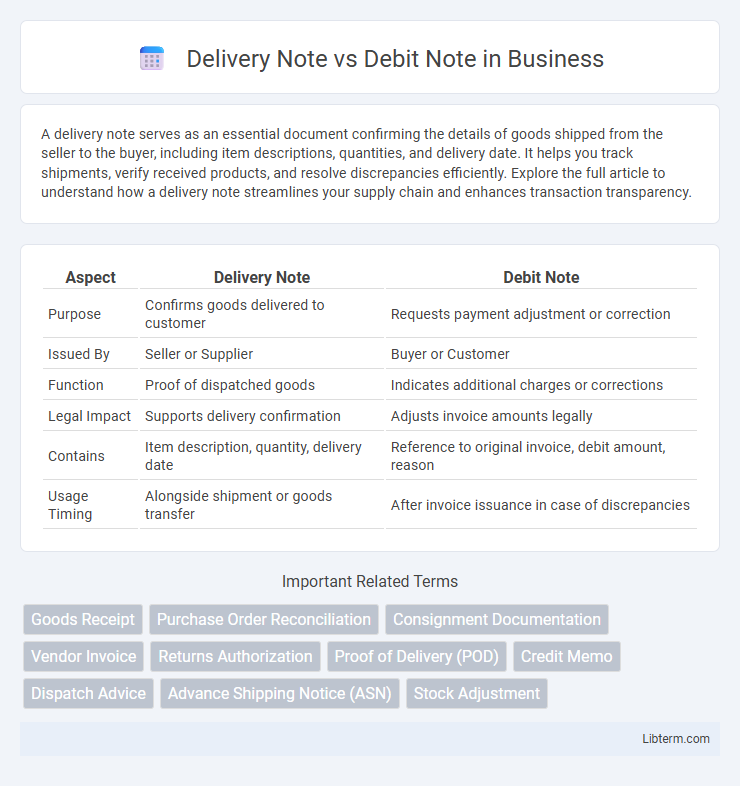A delivery note serves as an essential document confirming the details of goods shipped from the seller to the buyer, including item descriptions, quantities, and delivery date. It helps you track shipments, verify received products, and resolve discrepancies efficiently. Explore the full article to understand how a delivery note streamlines your supply chain and enhances transaction transparency.
Table of Comparison
| Aspect | Delivery Note | Debit Note |
|---|---|---|
| Purpose | Confirms goods delivered to customer | Requests payment adjustment or correction |
| Issued By | Seller or Supplier | Buyer or Customer |
| Function | Proof of dispatched goods | Indicates additional charges or corrections |
| Legal Impact | Supports delivery confirmation | Adjusts invoice amounts legally |
| Contains | Item description, quantity, delivery date | Reference to original invoice, debit amount, reason |
| Usage Timing | Alongside shipment or goods transfer | After invoice issuance in case of discrepancies |
Introduction to Delivery Note and Debit Note
A Delivery Note is a commercial document issued by the seller to the buyer, detailing the goods delivered and serving as proof of shipment. A Debit Note is a formal request from the buyer to the seller, indicating a return of goods or adjustment in the invoice due to discrepancies or errors. Both documents play crucial roles in maintaining accurate transaction records and resolving billing issues in supply chain management.
Definition of Delivery Note
A delivery note is a document sent with goods that details the items delivered, quantities, and specifications, serving as proof of shipment and receipt. It facilitates the verification of order completeness by both the supplier and the customer. In contrast, a debit note is a financial document issued to request payment or correct billing errors after delivery.
Definition of Debit Note
A debit note is a formal document issued by a buyer to a seller indicating a request for a credit adjustment due to discrepancies such as damaged goods or incorrect billing. It serves as a notification to the seller that the buyer intends to debit their account, often leading to an adjustment in the invoice or refund. Delivery notes, on the other hand, are documents accompanying shipments to confirm the details and receipt of goods without financial adjustments.
Key Differences Between Delivery Note and Debit Note
A Delivery Note serves as proof of goods dispatched, detailing quantities and items delivered to the customer, while a Debit Note is issued to notify customers of additional charges or corrections in billing. Delivery Notes are primarily used in logistics and inventory management to confirm receipt of goods, whereas Debit Notes function as financial documents to request payment adjustments or rectify invoice discrepancies. The key difference lies in their purpose: Delivery Notes validate physical delivery, whereas Debit Notes address transactional changes after invoicing.
Purpose and Importance of Delivery Notes
Delivery notes serve as crucial documents that accompany goods during shipment, providing detailed information about the items delivered, ensuring accuracy in order fulfillment and preventing disputes between sellers and buyers. They verify receipt of goods, facilitate inventory management, and support efficient tracking in the supply chain. The purpose and importance of delivery notes lie in their role as proof of delivery, enhancing transparency and accountability in logistics operations.
Purpose and Importance of Debit Notes
Debit notes serve as formal requests issued by buyers to sellers, indicating a need to adjust amounts due to discrepancies such as damaged goods, pricing errors, or quantity shortfalls in delivered items. Their purpose is to document and communicate claims for reductions in payment, ensuring accurate financial records and facilitating transparent dispute resolution between trading partners. These documents are crucial for maintaining proper accounting control and preventing payment disputes, thereby safeguarding both parties' financial interests.
Core Components of a Delivery Note
A Delivery Note typically includes essential components such as the delivery date, buyer and seller details, item descriptions, quantities, and signatures for acknowledgment of receipt. It serves as proof of goods handed over, ensuring accuracy in shipment and facilitating inventory management. Unlike a Debit Note, which addresses financial discrepancies, the Delivery Note focuses on the physical delivery and verification of products.
Core Components of a Debit Note
A debit note is a commercial document issued by a buyer to a seller, indicating a request for a credit adjustment due to discrepancies such as damaged goods, incorrect quantities, or pricing errors. Core components of a debit note include the debit note number, date of issue, buyer and seller details, reference to the original invoice, description of the goods or services, quantity, reason for the debit adjustment, and the amount debited. It serves as a formal request to amend the original transaction and facilitates accurate accounting and inventory management between trading parties.
When to Use a Delivery Note vs Debit Note
A Delivery Note is used when goods are shipped to confirm the items delivered match the order, serving as proof of receipt for both buyer and seller. A Debit Note is issued to notify the buyer of an increase in the amount owed, often due to returned goods, pricing errors, or additional charges after the original invoice. Use a Delivery Note during product dispatch and a Debit Note when adjustments to payments or billing corrections are necessary.
Conclusion: Choosing the Right Document
Selecting between a delivery note and a debit note depends on the nature of the transaction and documentation purpose. Delivery notes verify the receipt of goods, ensuring accurate shipping and inventory management, while debit notes address billing adjustments such as returned goods or undercharged amounts. Businesses optimize accounting accuracy and operational efficiency by using each document appropriately within supply chain and financial workflows.
Delivery Note Infographic

 libterm.com
libterm.com